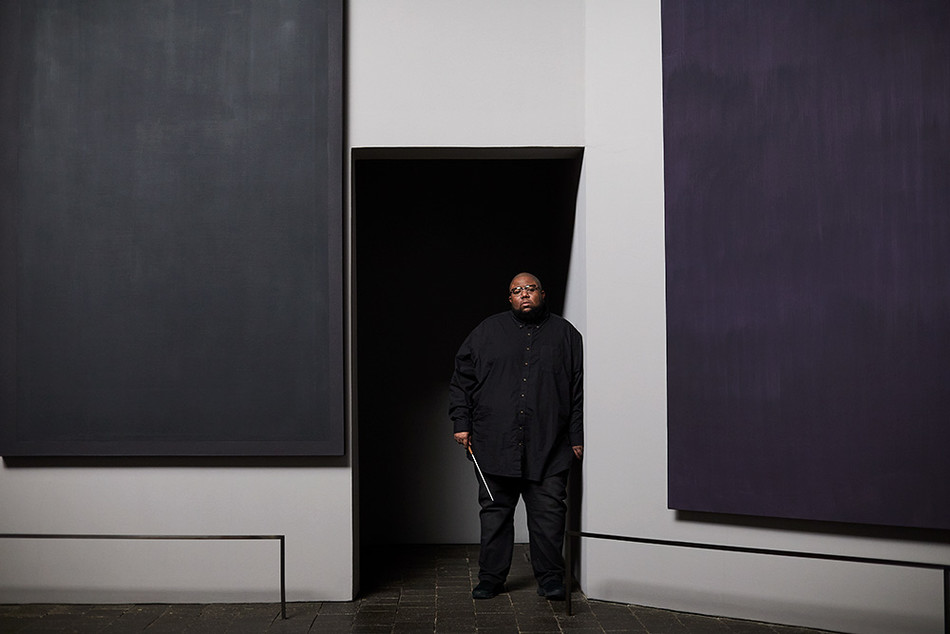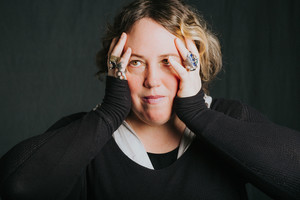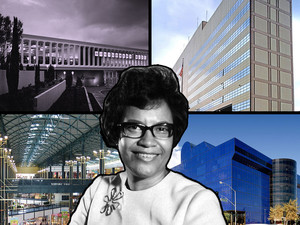The Meditative, Multihued Soundscapes of Tyshawn Sorey
Standing on the conductor’s podium, Tyshawn Sorey ’17GSAS summons colors with his baton, unplanned and unpredictable. Seated at the drums, he daubs his brushes on a moonfaced canvas, his ruminative gestures conjuring sound. A genre-defying composer and musician, Sorey, forty-two, is one of the most prodigiously talented, hardworking, and sought-after figures in the world of contemporary music, an artist who hears with his eyes and sees with his ears and whose works reflect a kaleidoscopic consciousness forever resolving itself into beguiling audio abstractions.
Since 2007, Sorey has released sixteen albums of highly individualistic music, from the hypnotic, plaintive dissonances of the fifty-three-minute chamber orchestral work For George Lewis (2021) to the percussive detonations and electric shredding of his 2020 session with guitarist Mike Sopko and bassist Bill Laswell (On Common Ground). As a composer, Sorey encompasses trans-European, Black, and world-music influences, as well as the American experimental tradition, ranging from postwar avant-garde giants John Cage and Morton Feldman to living legends Anthony Braxton and Roscoe Mitchell.
Many of Sorey’s works, like Trio for Harold Budd (for alto flute, piano, and vibraphone) and For Roscoe Mitchell (for cello and orchestra), with their mellow colorations and extraplanetary time signatures (37/16, anyone?), have fully notated scores. Others, like Autoschediasms (2021), are composed in the moment, with Sorey using gestures inspired by “conduction,” a system of hand signals developed by another of his mentors, the cornetist and composer Butch Morris, to cue performers to respond instantly and interpretatively. Sorey is a great believer in the power of artistic collaboration, and performances of his works are acts of intense spiritual and emotional communion.
“People listen to music either for enjoyment or else to get a new perception — whether that involves digging deeper inside of themselves or trying to get a better understanding of something they haven’t heard before,” says Sorey. “I try to give listeners something to take with them, a different kind of energy and feeling.”
A 2017 MacArthur fellow, Sorey is a musical universalist who has little use for categories and labels. He feels they are reductive and irrelevant in a post-genre world and often attaches a wary prefix to them: “so-called jazz,” “so-called classical,” “so-called hip-hop.” Nor does he care for the word “improvisation,” which as a musical strategy is frowned upon, he says, by “insecure composers or people who are mean-spirited about the idea of creating something spontaneous.” Sorey prefers the term “spontaneous composition,” since, he says, he is always composing, always thinking of structure, whether he’s writing at the piano (what he calls “formal composition”) or playing an instrument (a world-class drummer, Sorey is also a self-taught pianist and a classically trained trombonist).
Sorey’s music has a haunting, ethereal beauty that illustrates his fascination with negative space, or silence, which gives, he says, “a certain ecstasy — the decay of a piano or a vibraphone, the emptiness left when a violin stops playing. The energy you get after hearing these sounds is what I try to capture with the silences: periods where the energies of what has been played are reflected onto the listener.” Last year, Sorey conducted Monochromatic Light (Afterlife), a work for percussion, viola, celesta, choir, piano, and vocal soloist that incorporates visual art and choreography, which he composed for the fiftieth anniversary of the Rothko Chapel in Houston, home to fourteen large Mark Rothko canvases painted in shades of black. It was an especially meaningful commission, since one of Sorey’s heroes, Morton Feldman, composed Rothko Chapel, a modernist classic, which premiered a year after the chapel’s 1971 dedication. Encountering the Rothko paintings for the first time, Sorey experienced what he called “an intimacy with silence,” saying that for him, black represents “near silence or silence itself.”
Silence is a luxury for Sorey. His schedule is a coffee-forward marathon of rehearsing, performing, composing, recording, teaching (he is a professor of music at the University of Pennsylvania), and parenting (he and his wife, the violinist and ethnomusicologist Amanda Scherbenske, have two daughters, age two and six). Yet he makes sure to find time for interviews: mindful of the ways in which Black orchestral composers have been mislabeled, misunderstood, and subjected to double standards, Sorey has been purposeful in defining himself and his music on his own terms.
In an empty practice room in Carnegie Hall, where he is rehearsing for an ensemble performance of The Witness, by the experimental composer Pauline Oliveros, Sorey sits down to chat. Gracious and accommodating, he opens up about his time at Columbia, a difficult, profoundly transformative period in his creative development — what you might call his Light-Blue Period.
Sorey was an internationally recognized musician when he entered Columbia’s PhD program in composition in 2011. He had released his first album of compositions, That/Not, in 2007 (a debut that featured a forty-three-minute piano piece of repeated, fading chords) but was best known as a virtuosic drummer who could play anything, a musical explorer with perfect pitch and an ability to quickly memorize complex scores. His list of collaborators already included such visionaries as Muhal Richard Abrams, Vijay Iyer, John Zorn, Roscoe Mitchell, Anthony Braxton, and the saxophonist and composer Steve Lehman ’12GSAS.
Like Lehman, Sorey had earned his master’s in composition from Wesleyan and studied with Braxton. He had come to Morningside Heights to work with another of his heroes, George Lewis, the MacArthur-winning composer, theorist, trombonist, author, and computer-music pioneer. But the scene in Dodge Hall wasn’t what Sorey had expected.
“The minute I got to Columbia, I had a major identity crisis,” Sorey says. “I thought I would be entering some post-Cage, post-Feldman continuum” — a practice that embraced elements of chance, performer agency, and nontraditional notation — “but some students there at the time weren’t about that. Compositionally, my interests didn’t align with theirs.” First-year students had to present a work and talk about it, and Sorey presented one of his. “Some of the reactions I got were rather” — Sorey pauses. “There were a lot of dismissive attitudes toward what I did. People said, ‘Well, that’s not composition, that’s not what it’s supposed to be.’”
Sorey was devastated. For the next two years he tried to fit in, suppressing his own artistic impulses to gain acceptance. “I will be frank about this,” he says. “It was a very, very rough journey. I was trying to be this academic type of composer, but I hated what I was writing.”
Still, there were other students who shared his eclecticism and interest in spontaneity, including Lehman and Courtney Bryan ’14GSAS, an award-winning composer of orchestral and choral works. Sorey cherished those relationships, “but for the most part, it was a weird situation for me,” he says. “Admittedly, I had some social things I needed to work out. It wasn’t that I didn’t get along with people. It was more that I was a loner, and I felt even more alone at Columbia.”
As far back as childhood, Sorey, with his unbounded musical tastes, felt like an “odd man out,” he says. Born in 1980 and raised in an economically depressed area of Newark, he got his musical education wherever he found it: in the barbershop (his barber would give him gifts of old R&B 45s after every haircut); in church (raised Catholic, he would play hymns by ear on the church piano); in the record store (where he discovered that music could be divided into discrete categories); in the clubs (house music, mostly); in the streets (hip-hop, salsa); and in the schools (where he picked up the last trombone in the music room). At home he used pots and pans to drum along with the radio, and when he was twelve his grandfather got him a drum set. “He spent what little money he had on me. A no-name kit. But it had all the pieces, everything I needed. I practiced in the basement every day.”
Among his other household resources was the radio, often tuned to WBGO (jazz) or Columbia’s WKCR. “Those stations really found me,” Sorey says. “’KCR played everything from Mississippi Delta blues to contemporary classical music to noise to straight-ahead jazz to avant-garde. I didn’t know what the hell I was listening to, but I was able to really appreciate it.” He would record stuff off the radio onto cassette tapes and listen obsessively. He later attended Newark’s Arts High School, which, to Sorey’s amazement, did not have a jazz band. So he found some older students who were into jazz, and they’d jam together off-hours. A teacher got them into the Newark Jazz Festival and Kimako’s Blues People, a music venue and salon operated out of the poet Amiri Baraka’s basement, where Sorey saw pianists John Hicks and Big John Patton and trombonist Grachan Moncur III.
It was around this time that he started thinking about dedicating his life to music. He began composing in high school and continued to write as a jazz-studies major at William Paterson University. At Wesleyan, Braxton stoked his interest in John Cage, Anton Webern, and the artists in the Association for the Advancement of Creative Musicians. Founded in Chicago in 1965 by Muhal Richard Abrams, among others, to support “serious, original music” and build community for Black experimental musicians, the organization has included Braxton, Roscoe Mitchell, Wadada Leo Smith, Lewis, and others who to Sorey stood as models of uncompromising personal expression.
At Columbia, it was in fact Lewis who helped Sorey heed his own muse. Lewis had worked with many great artists and found that Sorey shared their best qualities: “openness to change and new ideas, perspicacity, ability to face fears, leaving no creative stone unturned, and listening to everything, and I mean everything,” Lewis says. “Certainly, Tyshawn taught me as much as I might have taught him.” Lewis also referred Sorey to another professor, the composer Fred Lerdahl (now emeritus). “Fred said, ‘Your music is speaking two languages, and you need a unified language,’” Sorey recalls. “‘You are so coherent as an improviser — why doesn’t your composition have that same coherency? You have to address that.’”
As Lerdahl remembers, Sorey wanted to learn two things: chromatic harmony and compositional form. “Tyshawn has always had an interest in the work of Morton Feldman — very slow, moving at a large scale, with a kind of spiritual state of mind,” Lerdahl says. “But he wasn’t sure how far to go, how much repetition to do, when to find contrast. I helped with that. One thing about Tyshawn is that while he’s very confident in his abilities, he’s always been extremely open and clearheaded about wanting to learn.”
“I try to give listeners something to take with them, a different kind of energy and feeling.”
“Those first meetings with Fred changed my life,” Sorey says. “In my first lesson, I broke down in front of him, telling him I felt I was a failure, that I wasn’t going to be a successful composer, that I should just go back to playing my jazz gigs and call it a day. He said, ‘No. Don’t do that.’” Sorey got a similar reaction from another professor, Chris Washburne ’98GSAS. Sorey didn’t study with Washburne, but he was his TA for four years, and they became close. “Tyshawn is just an extraordinary human being and an extraordinary artist,” says Washburne. “And as a teacher he goes above and beyond in the care of students.”
Sorey’s doctoral dissertation, which Lerdahl sponsored, was both an introspective musical mission statement and a discussion of Perle Noire: Meditations for Joséphine, Sorey’s song cycle about Josephine Baker, the expatriate American singer, dancer, and actor. Written for the soprano Julia Bullock and directed by Peter Sellars, with text by poet Claudia Rankine ’93SOA, Perle Noire premiered in 2016 at the Ojai Music Festival and addressed Sorey’s abiding social and artistic concerns, tackling identity and race relations while questioning, as he wrote, “assumed distinctions between improviser and composer and improvisation and composition.” The piece, which the New York Times called “one of the most important works of art yet to emerge from the era of Black Lives Matter,” was later performed in New York at the Metropolitan Museum of Art.
“It took me four years to get to the point where I could say, ‘This is who I am, this is what I do, and if you don’t like it, don’t listen,’” says Sorey. “Four years to develop that kind of confidence. If not for George, Fred, and Chris, we wouldn’t be sitting here right now.”
A week after performing Oliveros’s The Witness at Carnegie Hall, Sorey is at Columbia for a concert at Miller Theatre. On this night, Sorey, who premiered several pieces at Miller in 2019 as part of the Composer Portraits series, is playing with the Vijay Iyer Trio, with Iyer on piano and Linda May Han Oh on bass. As the group settles at their instruments, Iyer, who has called Sorey “a bona fide genius,” reminds the audience that “Tyshawn became a doctor in this building.” That brings whistles and applause, and then the musicians slide into a complex, intuitive interplay that some might consider modern or experimental jazz but which Sorey simply calls “creative music.”
Sorey, dressed in black, dashes his sticks and brushes, splashes his colors. Eyes closed, ears wide open, he caresses the cymbals, stirs the snare, raises rolling waves, sibilant whispers, and crackling fusillades that fairly burst into light.
When it’s over, Sorey greets well-wishers and breaks down his set. The audience leaves, the lights go out. With any luck, Sorey’s schedule will permit him a few hours of dreamless, soundless sleep: the silence of meditation, of Rothko’s black canvases. Sorey had spoken of it a week before, at Carnegie Hall.
“As Roscoe Mitchell put it: silence is perfect,” Sorey said. “And so I’m just trying to produce music that I hope is as beautiful to others as silence is to me.”
This article appears in the Spring/Summer 2023 print edition of Columbia Magazine with the title "Self-Composed."



